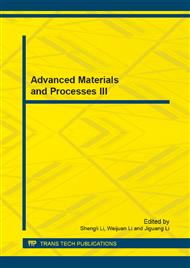p.116
p.121
p.125
p.133
p.138
p.144
p.149
p.154
p.158
Electrospun Ketoprofen Sustained Release Nanofibers Prepared Using Coaxial Electrospinning
Abstract:
The present study investigates the preparation of sustained release drug-loaded nanofibers using a modified coaxial electrospinning process where only solvent is exploited as sheath fluid. Drug-loaded ethyl cellulose (EC) nanofibers are successfully generated smoothly and continuously without any clogging through the coaxial process, in which ethanol is used as sheath fluid and EC and ketoprofen (KET) are taken as the filament-forming matrix and active pharmaceutical ingredient, respectively. Field-emission scanning electron microscopic observations demonstrated that the nanofibers diameter can be manipulated through the sheath fluid flow rate. The composite nanofibers are in essential a molecular solid dispersion of EC and KET based on the hydrogen bonding between them, as verified by XRD and ATR-FTIR results. In vitro dissolution tests show that KET in the nanofibers has a fine sustained release profile via a typical Fickian diffusion mechanism. The modified coaxial electrospinning with solvent as sheath fluid can be a useful tool for developing novel sustained release drug delivery nanofibers.
Info:
Periodical:
Pages:
138-143
Citation:
Online since:
September 2013
Authors:
Price:
Сopyright:
© 2013 Trans Tech Publications Ltd. All Rights Reserved
Share:
Citation:


